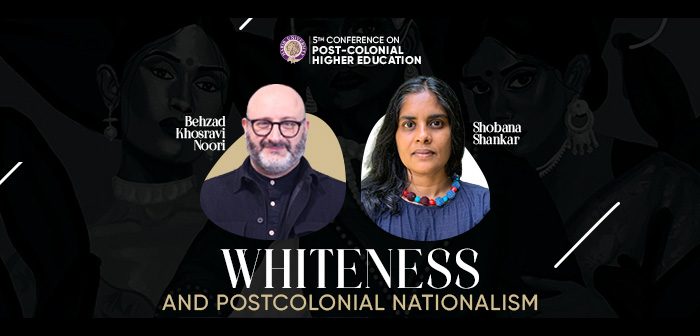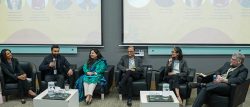The second session of the Fifth Post-Colonial Higher Education Conference was titled ‘Whiteness and Postcolonial Nationalism’ which featured Professor at the Department of History, Stony Brook University, USA, Shobana Shankar and Assistant Professor of Practice in the Communication and Design program at Habib University, Behzad Khosravi Noori, as panelists. Najeeb Jan, Associate Professor in the Comparative Humanities program at Habib University, moderated the session with Dr. Nauman Naqvi, Conference Chair, as discussant.
Professor Shankar began her lecture by proposing that a history of whiteness must include the intimate and complex relationship between Africans and Africa, and South Asians and South Asia. “This relationship,” she explained, “is often but not always unfolding ad transformed in the presence or shadow of Europeans, but this is Afro South Asian relationship also informed European’s ideas of others and themselves.” Owing to her extensive research in modern Africa, the African diaspora and African-Indian encounters, Professor Shankar shed light on how the mobilities of Africans and South Asians, and their globalized spaces are unparalleled. Africans and South Asians constitute two of the world’s largest diasporas, and their long interactions have unfolded through migration, labor, imperialism and in the global making of difference, social systems of difference and race-making.
Whiteness cannot be disentangled from European encounters with non-European subaltern subjects. Africans and South Asians have been agents in the making of difference that includes but is not always racial categories, she went on to say.
“Race, of course, is an idea, not a fact. It is not a biological difference but a constructed and reconstructed form of difference that includes a set of shifting discourses and practices of human difference.” Through her work, Professor Shankar argues that we must look at ideas of genealogy, blood, skin colour, gender, sexuality, religion, purity, occupation, ability, ideas about nature, human nature, in considering what is race and what is not a race.
“Whiteness as an idea does exist outside of the West and even in the West…for most of the past centuries, the belief in more than one European race has existed in America and beyond. So, in other words, South Asia and Africa have become critical spaces to fracture the idea of whiteness,” she went on to say.
Professor Shankar argued that the making of whiteness is tied to the making of Blackness in Afro-South Asian history, suggesting that we see whiteness and blackness as evolving ideas and ideologies in South Asia, transforming through South Asian interactions in African and Black politics.
Dr. Behzad Khosravi Noori delved into how much one could make the notion of whiteness within the transnational form of identification more complex. He attempted to navigate the relationship between different ideas of whiteness and the idea that of Aryanism and the effect of the notion of a concept of Aryanism in Persia/Iran.
In his artistic way, he pointed out that he believes whiteness is one of the main challenges of societies today. His lecture explored when we became Aryan: “There is some sort of internalization of the idea of Aryanism and Blackness within Iranian society and Iranian political mentality, and I try to navigate where it is from and how we could find it false.”
French novelist Arthur De Gobineau, Dr. Behzad said, was argued to be the father of racism. He explored how the Frankish-German idea became the main idea of Aryanism in Europe. “For the first time, Arthur claimed that the Persians were once great Aryans. He understood that we are not Middle Eastern or West Asian, Asian, or Arab – we are Aryan,” Dr. Noori pointed out. Persians had been interbred too often with the Semitic Arabs as their own Persian tragedy was in his work. He thought that it was the land without racial prejudice. He was shocked that Persians regarded black as equal.
Arthur De Gobineau was the only person to define 19th century Iran as democratic. Dr. Noori found this interesting because the only democracy in his mind was the land without racial distinction and hierarchy. He said that they could be the closest cousin of our white Europeans. “If you are Persian, you are Aryan – European Aryan. So, they were white.”
Furthermore, Dr. Noori went on to point out that Gobineau also believed that Shia Islam was part of a revolt by the Aryan Persians against the Semitic Arabs, seeing a close connection between Shia Islam and Persian nationalism.




